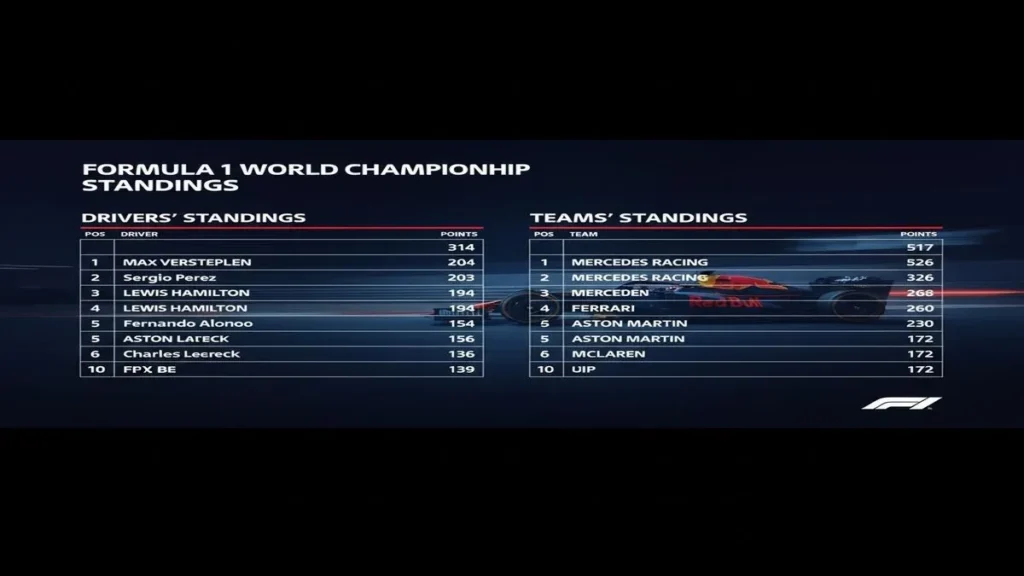GENERAL
Understanding Formula 1 Standings and Championship Rankings

Formula 1 Standings refer to the official tables that display the current positions of drivers and teams based on their cumulative points throughout a season. Points are awarded according to race results, and those in higher positions earn more. The driver and team with the most points at the end of the season are crowned the World Champions in their respective categories.
These official rankings are maintained and regulated by the Fédération Internationale de l’Automobile (FIA), the global governing body responsible for overseeing Formula 1 and ensuring the integrity and fairness of the competition.
The standings are a barometer for performance and consistency, enabling fans, teams, and analysts to track progress from the opening race to the final Grand Prix.
Table of Contents
Two Main Categories of Formula 1 Standings
The Formula 1 Standings are divided into two major classifications:
1. Drivers’ Championship
The Drivers’ Championship ranks individual competitors based on their total points across all races in a season. Each driver earns points according to their finishing position in a race. For instance, the race winner receives 25 points, second place gets 18, third earns 15, and so on down to 10th place, which receives 1 point.
Additional points are available for achieving the fastest lap (if the driver finishes within the top ten), making every lap of the Grand Prix potentially significant in the final standings.
Winning the Drivers’ Championship is one of the highest honors in motorsport, symbolizing a driver’s talent, mental resilience, and adaptability across diverse circuits and weather conditions.
2. Constructors’ Championship
The Constructors’ Championship evaluates the collective performance of each team, or “constructor,” based on the combined points earned by its drivers. For example, if both drivers from a team finish in point-scoring positions, their totals contribute to the team’s overall tally.
This ranking emphasizes teamwork, engineering excellence, and strategic depth. To succeed, a team must deliver not only fast cars but also consistent reliability and pit crew precision.
Winning the Constructors’ Championship often highlights the technical superiority and coordination of the team, showcasing the innovation behind Formula 1 engineering.

How Formula 1 Points Are Awarded
The Formula 1 points system has evolved, but the current structure rewards the top 10 finishers in each race:
| Position | Points Awarded |
| 1st | 25 |
| 2nd | 18 |
| 3rd | 15 |
| 4th | 12 |
| 5th | 10 |
| 6th | 8 |
| 7th | 6 |
| 8th | 4 |
| 9th | 2 |
| 10th | 1 |
An extra point is awarded for the fastest lap, provided the driver finishes in the top 10. In addition, Sprint Races, shorter races held during certain weekends, also contribute to the Formula 1 Standings, with separate points allocated to the top eight finishers.
Tiebreaker Rules in Formula 1 Standings
Occasionally, two drivers or teams may finish a season with the same number of points. In such cases, Formula 1 applies specific tiebreaker rules: the driver or team with greater race wins ranks higher. If the number of wins is also equal, the number of second-place finishes, third-place finishes, and so forth is compared until a difference emerges.
Why Formula 1 Standings Matter
The Formula 1 Standings are not just statistics; they define the entire narrative of a season. They determine championship titles, influence team strategies, and impact driver contracts and sponsorship deals.
From a fan perspective, the standings offer a clear and ongoing story of rivalry, perseverance, and progress. A single race can dramatically alter positions, making the championship unpredictable until the last lap.
Factors Influencing the Standings
Several key factors influence the evolution of Formula 1 Standings over a season:
- Car Performance: The competitiveness of a team’s car design, aerodynamics, and engine power directly affects race results.
- Driver Skill: Consistency, racecraft, and decision-making under pressure are crucial for scoring regular points.
- Team Strategy: Pit stop timing, tire choices, and tactical calls can significantly influence finishing positions.
- Weather Conditions: Changing weather can alter race outcomes, benefiting adaptable teams and drivers.
- Technical Reliability: Mechanical failures or penalties can cause dramatic shifts in standing.
Historic Impact of Formula 1 Standings
Over the decades, Formula 1 Standings have chronicled some of the most memorable rivalries and moments in sports history, such as Ayrton Senna vs. Alain Prost, Michael Schumacher’s record dominance, and Lewis Hamilton’s pursuit of multiple championships.
These standings are more than mere numbers; they reflect the evolution of technology, human ambition, and sporting excellence in every era of Formula 1.
Modern Era and Digital Accessibility
Today, Formula 1 Standings are updated instantly after each race and made available through official platforms like Formula1.com, the F1 mobile app, and broadcast coverage. Fans can track live standings, analyze performance trends, and compare drivers’ progress throughout the season in real time.
Data analytics has also become an integral part of modern F1, with detailed insights available for enthusiasts who wish to understand who is leading and why.
Constructors’ vs. Drivers’ Championship: Which Is More Prestigious?
While the Drivers’ Championship garners more public attention due to individual fame, the Constructors’ Championship carries immense importance within the sport. Manufacturers such as Ferrari, Mercedes, and Red Bull view it as a testament to their engineering prowess and innovation.
In many cases, dominance in the Constructors’ standings also correlates with technological advancements that shape the future of Formula 1 and even road car development.
FAQs
1. How often are Formula 1 Standings updated during a race weekend?
After each race or sprint session, they are updated immediately after official results are confirmed.
2. Can a driver win the Drivers’ Championship even if their team doesn’t win the Constructors’ title?
A driver can win the Drivers’ Championship independently of their team’s position in the Constructors’ Standings.
3. What happens if a race is cancelled or shortened? Do the Formula 1 Standings still change?
If a race is cancelled or shortened, points may be adjusted or not awarded, depending on how much the race was completed.
Conclusion
The Formula 1 Standings encapsulate the drama, precision, and competitive spirit that make Formula 1 the pinnacle of motorsport. They tell the story of each season from underdog comebacks to dominant streaks, revealing the intricate balance between human skill and mechanical mastery.
-

 GENERAL6 months ago
GENERAL6 months agoChristofle – For Those Who Dream of Family Heirloom Silver
-

 SPORTS8 months ago
SPORTS8 months agoDiscover the World of Football with Streameast: Watch Your Favorite Leagues and Tournaments
-

 GENERAL4 months ago
GENERAL4 months agoUncovering the World of кинокрадко: The Dark Side of Film Piracy
-

 GENERAL2 months ago
GENERAL2 months agoATFBooru: Anime, Gaming, and Subculture Imageboard























